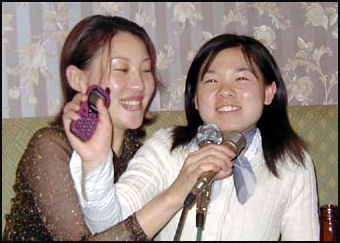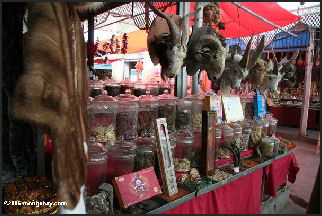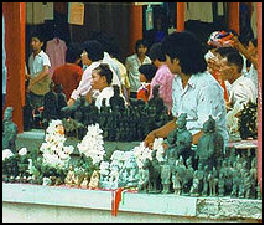ENTERTAINMENT

Karaoke
Nightclubs are generally very expensive and not very common outside of Beijing and Shanghai. They often have a floor show and are located at major hotels. Discos are generally expensive and frequented by affluent, fashion-conscious types. Casinos, legal ones anyway, are found im Macao but not on the mainland. Illegal gambling halls are common throughout China. Hostess Bars are where men pay extra for their drinks so that they can be flattered and served by young hostesses, who may or may not be prostitutes.
Hotel Bars are lounges or bars found in first class hotels. The atmosphere is cozy, and many of them are located on the top floors of hotels, where there are wonderful views of the city. Beer Halls are beer-halls pubs that vary a great deal in atmosphere and price. Most serve pitchers of beer and customers are usually required to buy a food dish.
Karaokes and karaoke-style singing rooms are very popular in China. They can either be a place where people sing in front of the whole bar or more often are places where people rent a room by the hour that is large enough for a group of friends. There is generally a karaoke machine with a television that displays images and lyrics and a book with the songs with mostly Chinese but usually some English songs. You can bring own food and drinks.
Coffee Shops are different from their counterparts in the West. Customers come her to relax over a cup of coffee and many coffee shops specialize in a certain kind of music such as classical music, hard rock or jazz. They serve deserts but not meals. Tea Houses have traditionally been places where people hang out and socialize and have relaxed conversations. Chinese teahouses vary quite a bit from place to place. Neighborhood- and village-based one charge the equivalent of a few cents for a bowl of tea. Trendy urban ones charge around US$4 ot US$5 dollars for tea and rice sweets and offer black tea, 10-herb mixture (“good for a lift”), ginseng tea, quince tea. ginger tea and plum (“for relief from fatigue”).
THINGS TO BUY

Kashgar market
Bargaining and haggling is the norm except at the malls and upscale shops. Reductions of 70 percent to 80 percent are common. Merchants quote over-the-top prices that are sometimes 20 times higher than the price paid by locals. Generally, offer about 10 percent of the asking price and expect to pay 20 percent or 30 percent. Inflation is problem in China so tourists should be prepared to pay double or triple the prices that were offered a decade ago. In the past Friendship stores were only places you could buy foreign items and quality Chinese goods, but now almost every large city or town has a half dozen department stores and shopping malls with a variety of foreign and local goods.
China is famous for its jade items and oriental art. Among the interesting items you can buy are cheap toys, antique curios, hand-painted scrolls, jade seals, chopsticks, paper lanterns, umbrellas, folk medicines, blue and white ceramics, brassware, antique furniture, silk embroideries, folk crafts, jade and soapstone carvings, watercolor paintings, calligraphy, calligraphy sets, silk carpets, silk cushion covers, terra-cotta pots, herbs, spices, tea, bamboo bird cages, and porcelain cricket cages.
You can also get embroidered hill tribe handbags, baskets, belts, caged birds and turtles, kites, pot holders, aprons, napkins, fans, puppets, masks, T-shirts, illustrated art books, jewelry and ornaments made from silver and bronze, lacquered boxes, handmade dolls, cork sculptures, stuffed pandas, turquoise jewelry, carved salad bowls, handmade glasses, bone bracelets, socket wrenches, screwdrivers, plumber's tools, wicker baskets, cashmere sweaters and thermos jugs.

Antique items which can be picked at markets include incense burners, hammered silver tobacco boxes, old embroidered silk clothes, bonnets, jade wine cups, old brass padlocks, wooden images of gods and goddesses, silver fingernails, decorated hairpins, perfume jars, snuff containers, pewter jars, teapots, dishes, ivory chopsticks and vases. Some are in quite good condition, some are damaged and many are fakes.Anything more than a 100 year sold is marked with a red seal and can not be taken out f the country without an export license.
Items found at Central-Asian-style bazaars in Western China included embroidered handbags, leather holsters, handmade knives, baskets, belts, shish kebabs, watermelons, melons, about twenty kinds of dried fruit, almonds, walnuts, mutton, but no pork. Markets in Tibet sell grey otter pelts, bead, silver, chunks of amber, ornaments. Good bargains can be had on carpets.
Image Sources: 1) CNTO (China National Tourist Organization; 2) Nolls China Web site; 3) Perrochon photo site; 4) Beifan.com; 5) tourist and government offices linked with the place shown; 6) Mongabey.com; 7) University of Washington, Purdue University, Ohio State University; 8) UNESCO; 9) Wikipedia; 10) Julie Chao photo site; 11) Poco pico blog; 12) Tropical Island blog
Text Sources: CNTO, New York Times, Washington Post, Los Angeles Times, Times of London, National Geographic, The New Yorker, Time, Newsweek, Reuters, AP, Lonely Planet Guides, Compton’s Encyclopedia and various books and other publications.
